Citroen C3 PICASSO RHD 2014 1.G Owner's Manual
Manufacturer: CITROEN, Model Year: 2014, Model line: C3 PICASSO RHD, Model: Citroen C3 PICASSO RHD 2014 1.GPages: 288, PDF Size: 8.38 MB
Page 1 of 288
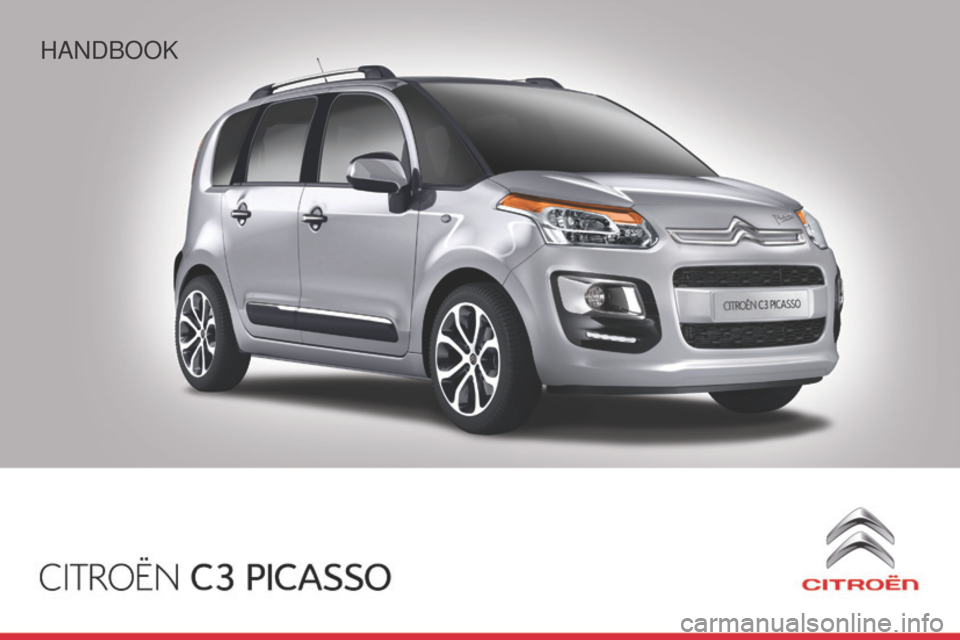
Handbook
Page 2 of 288
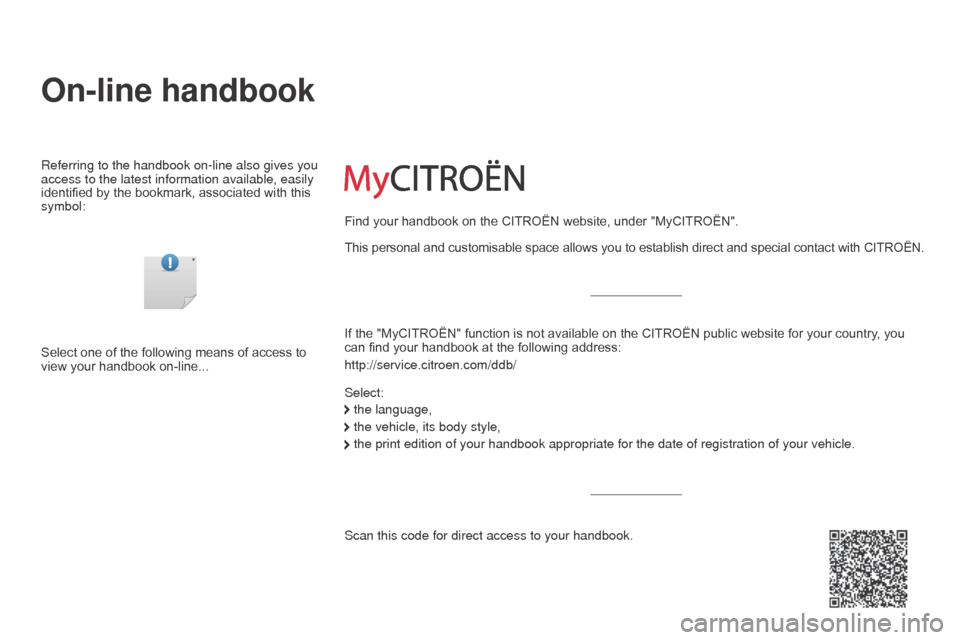
On-line handbook
Referring to the handbook on-line also gives you
access to the latest information available, easily
identified by the bookmark, associated with this
symbol:If the "MyCITROËN" function is not available on the CITROËN public website for your country , you
can find your handbook at the following address:
http://service.citroen.com/ddb/
Select:
Select one of the following means of access to
view your handbook on-line... This personal and customisable space allows you to establish direct and special contact with CITROËN.
the language,
the vehicle, its body style,
the print edition of your handbook appropriate for the date of registrat\
ion of your vehicle.
Find your handbook on the CITROËN website, under "MyCITROËN".
Scan this code for direct access to your handbook.
Page 3 of 288
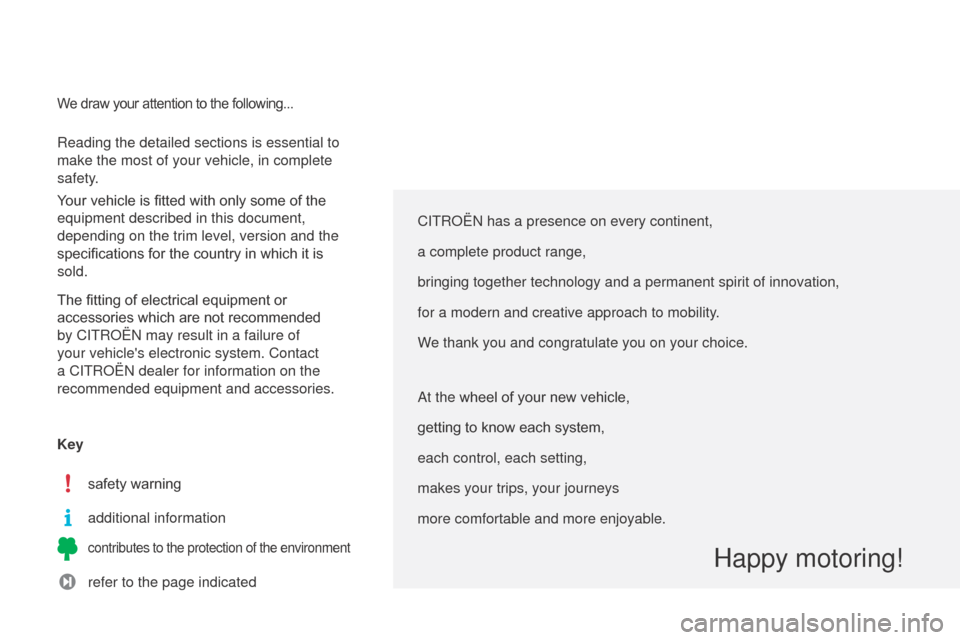
CITRoËn has a presence on every continent,
a complete product range,
bringing together technology and a permanent spirit of innovation,
for a modern and creative approach to mobility
.
We thank you and congratulate you on your choice.
Happy motoring!
at the wheel of your new vehicle,
getting to know each system,
each control, each setting,
makes your trips, your journeys
more comfortable and more enjoyable.
refer to the page indicated
Key
contributes to the protection of the environment
additional information safety warning
Reading the detailed sections is essential to
make the most of your vehicle, in complete
safety.
Your vehicle is fitted with only some of the
equipment described in this document,
depending on the trim level, version and the
specifications for the country in which it is
sold.
The fitting of electrical equipment or
accessories which are not recommended
by CITR
o Ë n may result in a failure of
your vehicle's electronic system. Contact
a CITR o Ë n dealer for information on the
recommended equipment and accessories.
We draw your attention to the following...
Page 4 of 288

.
.
Child seats 93
dea
ctivating the passenger's front airbag
9
6
Isofix child seats
1
01
Child lock
1
05
Child safety
Instrument panel 1 0
Indicator and warning lamps
1
1
Indicators
2
0
a
djustment buttons
2
3
MonitoringOver view
Screens with audio system 2
4
Trip computer
3
5
Multifunction screens
Ventilation 38
Rear screen demist /defrost
4
0
Heating
4
1
Manual air conditioning
4
1
Dual-zone digital air conditioning
4
3
Scented air freshener
4
6
Front seats
4
7
Rear seats
5
0
Mirrors
5
2
Steering wheel adjustment
5
3
Comfort
Remote control key 54
Window controls
5
9
Doors
61
Boo
t
6
4
Panoramic sunroof
6
5
Fuel tank
6
6
Misfuel prevention (
die
sel)
6
8
access
Lighting controls 69
LED lamps
7
3
Cornering lighting
7
4
Headlamp adjustment
7
5
Wiper controls
7
6
Courtesy lamps
7
9
Boot lamp
8
1
Visibility
Front fittings 82
Rear fittings
8
6
Boot fittings
8
9
Fittings
Eco-driving
Contents
Page 5 of 288
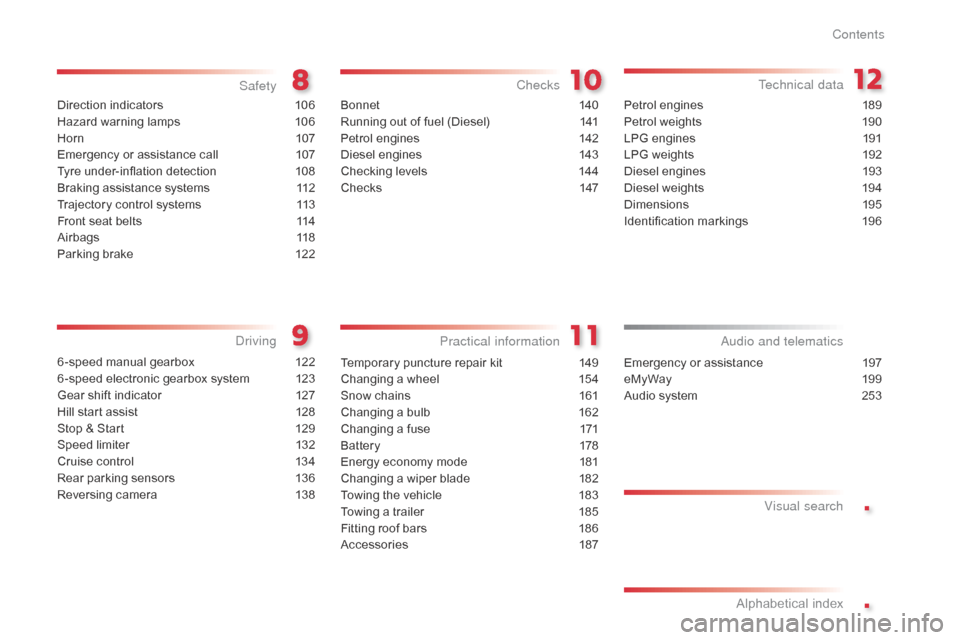
.
.
Direction indicators 106
Hazard warning lamps
1
06
Horn
10
7
Emergency or assistance call
1
07
Tyre under-inflation detection
1
08
Braking assistance systems
1
12
Trajectory control systems
1
13
Front seat belts
1
14
Airbags
1
18
Parking brake
1
22
Safety
6 -speed manual gearbox 122
6 -speed electronic gearbox system
1
23
Gear shift indicator
1
27
Hill start assist
1
28
Stop & Start
1
29
Speed limiter
1
32
Cruise control
1
34
Rear parking sensors
1
36
Reversing camera
1
38
driving
Emergency or assistance 1 97
eMyWay
19
9
Audio system
2
53
audio and telematics
Alphabetical index Visual search
Bonnet 14
0
Running out of fuel (Diesel)
1
41
Petrol engines
1
42
Diesel engines
1
43
Checking levels
1
44
Checks
14
7
Checks
Temporary puncture repair kit 149
Changing a wheel
1
54
Snow chains
1
61
Changing a bulb
1
62
Changing a fuse
1
71
Battery
1
78
Energy economy mode
1
81
Changing a wiper blade
1
82
Towing the vehicle
1
83
Towing a trailer
1
85
Fitting roof bars
1
86
Accessories
1
87
Practical information Technical data
Petrol engines 1
89
Petrol weights
1
90
LPG engines
1
91
LPG weights
1
92
Diesel engines
1
93
Diesel weights
1
94
Dimensions
1
95
Identification markings
1
96
Contents
Page 6 of 288
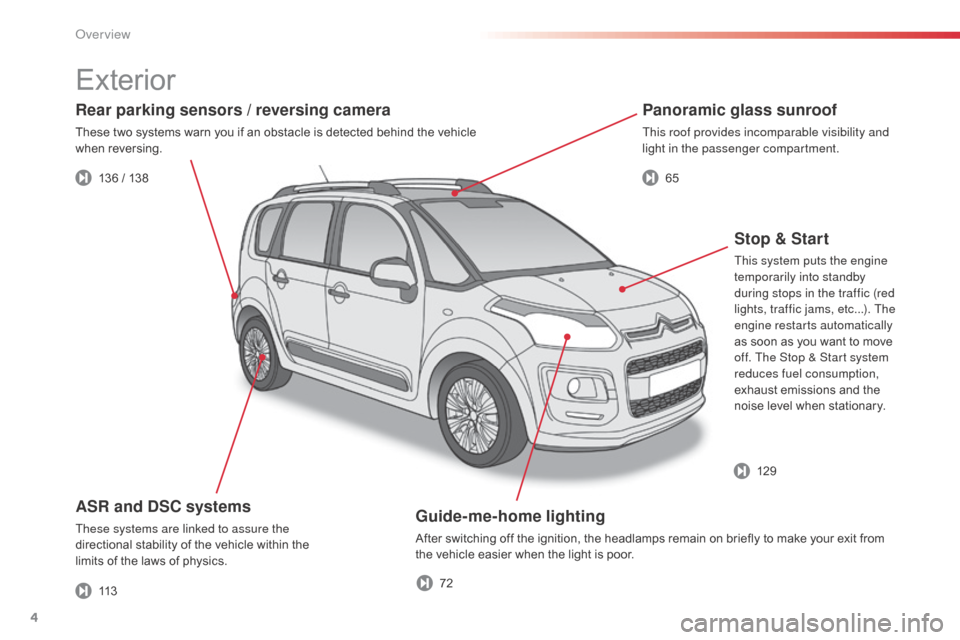
4
Guide-me-home lighting
After switching off the ignition, the headlamps remain on briefly to make your exit from
the vehicle easier when the light is poor.
ASR and DSC systems
These systems are linked to assure the
directional stability of the vehicle within the
limits of the laws of physics.
Panoramic glass sunroof
This roof provides incomparable visibility and
light in the passenger compartment.
Rear parking sensors / reversing camera
These two systems warn you if an obstacle is detected behind the vehicle
when reversing.113
Stop & Start
This system puts the engine
temporarily into standby
during stops in the traffic (red
lights, traffic jams, etc...). The
engine restarts automatically
as soon as you want to move
off. The Stop & Start system
reduces fuel consumption,
exhaust emissions and the
noise level when stationary.
Exterior
136 / 138 65
72 129
Over view
Page 7 of 288
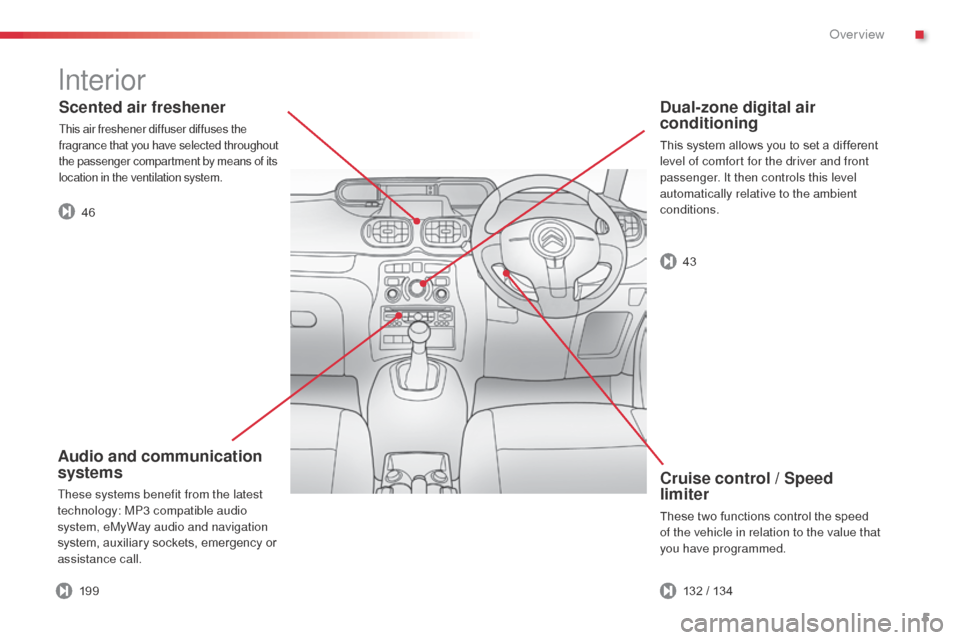
5
Dual-zone digital air
conditioning
This system allows you to set a different
level of comfort for the driver and front
passenger. It then controls this level
automatically relative to the ambient
conditions.
Cruise control / Speed
limiter
These two functions control the speed
of the vehicle in relation to the value that
you have programmed.43
132 / 134
Scented air freshener
This air freshener diffuser diffuses the
fragrance that you have selected throughout
the passenger compartment by means of its
location in the ventilation system.
19 946
Interior
Audio and communication
systems
These systems benefit from the latest
technology: MP3 compatible audio
system, eMyWay audio and navigation
system, auxiliary sockets, emergency or
assistance call.
.
Over view
Page 8 of 288

6
Instruments and controls
1. Steering lock and ignition.
2. au dio system steering mounted controls.
3.
W
ipers / screenwash / trip computer control
stalk.
4.
I
nstrument panel.
5.
d
r
iver's airbag.
Horn.
6.
G
ear lever.
7.
o
pe
n storage compartment.
8.
d
o
or mirror controls.
E
lectric window controls.
R
ear electric windows and doors
deactivation control.
9.
P
assenger's airbag deactivation.
10.
M
anual headlamp height adjustment.
11.
F
ront side window demisting vent.
12 .
W
indscreen demisting vent.
over view
Page 9 of 288
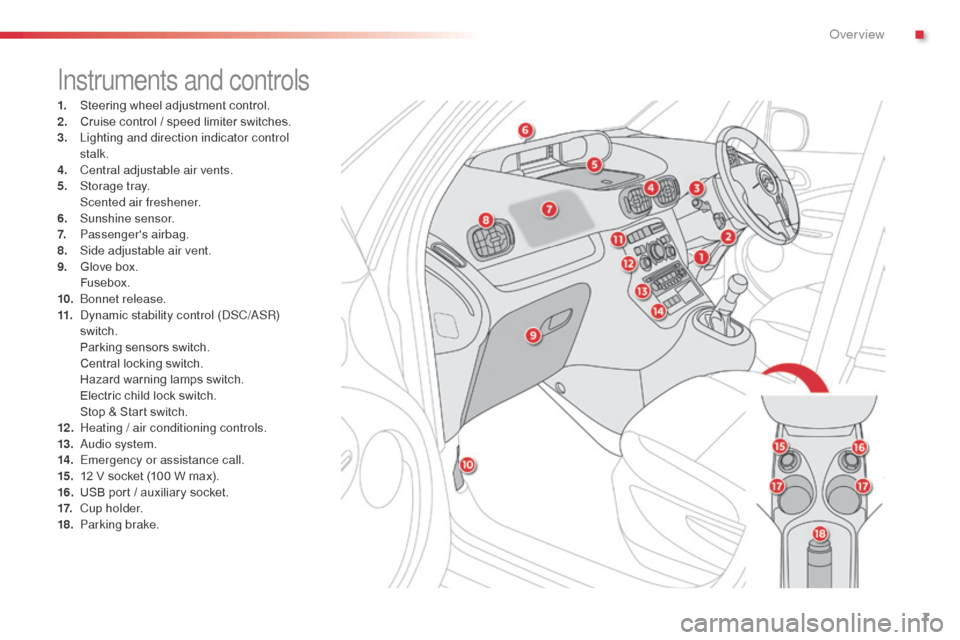
7
Instruments and controls
1. Steering wheel adjustment control.
2. Cruise control / speed limiter switches.
3.
L
ighting and direction indicator control
stalk.
4.
C
entral adjustable air vents.
5.
St
orage tray.
S
cented air freshener.
6.
S
unshine sensor.
7.
P
assenger's airbag.
8.
S
ide adjustable air vent.
9.
G
love box.
F
usebox.
10.
b
o
nnet release.
11.
d
y
namic stability control (
dSC
/
aS
R)
switch.
P
arking sensors switch.
C
entral locking switch.
H
azard warning lamps switch.
E
lectric child lock switch.
S
top & Start switch.
12 .
H
eating / air conditioning controls.
13.
a
u
dio system.
14 .
E
mergency or assistance call.
15.
1
2 V socket (100 W max).
16.
U
SB port / auxiliary socket.
17.
C
u p h o l d e r.
18.
P
arking brake.
.
over view
Page 10 of 288
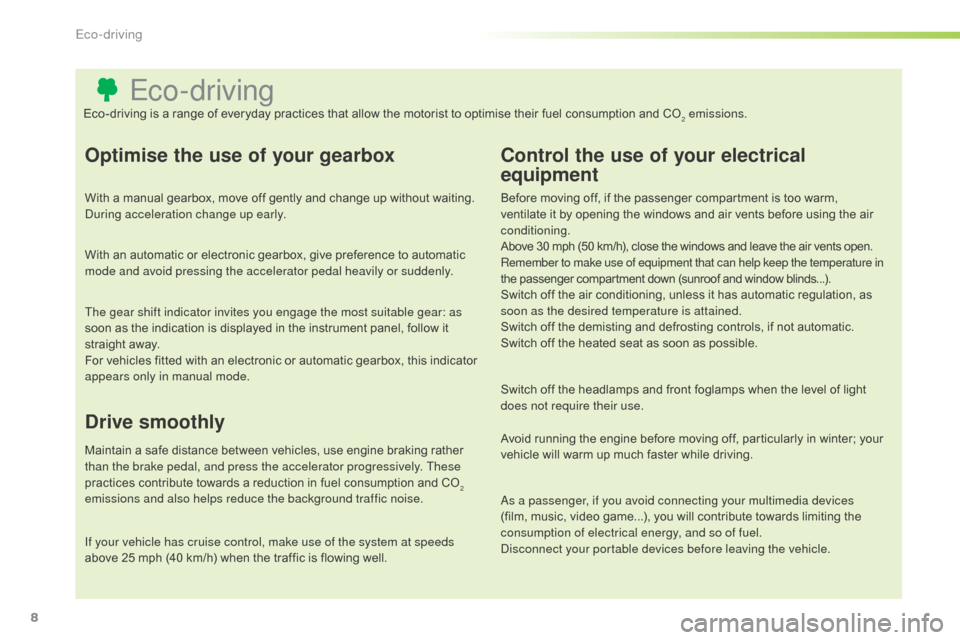
8
Eco-driving
Optimise the use of your gearbox
With a manual gearbox, move off gently and change up without waiting. during acceleration change up early.
With an automatic or electronic gearbox, give preference to automatic
mode and avoid pressing the accelerator pedal heavily or suddenly.
The gear shift indicator invites you engage the most suitable gear: as
soon as the indication is displayed in the instrument panel, follow it
straight away.
For vehicles fitted with an electronic or automatic gearbox, this indicator
appears only in manual mode.
Drive smoothly
Maintain a safe distance between vehicles, use engine braking rather
than the brake pedal, and press the accelerator progressively. These
practices contribute towards a reduction in fuel consumption and CO
2
emissions and also helps reduce the background traffic noise.
Control the use of your electrical
equipment
Before moving off, if the passenger compartment is too warm,
ventilate it by opening the windows and air vents before using the air
conditioning.
Above 30 mph (50 km/h), close the windows and leave the air vents open.
Remember to make use of equipment that can help keep the temperature in
the passenger compartment down (sunroof and window blinds...).
Switch off the air conditioning, unless it has automatic regulation, as
soon as the desired temperature is attained.
Switch off the demisting and defrosting controls, if not automatic.
Switch off the heated seat as soon as possible.
Switch off the headlamps and front foglamps when the level of light
does not require their use.
Avoid running the engine before moving off, particularly in winter; your
vehicle will warm up much faster while driving.
as a p
assenger, if you avoid connecting your multimedia devices
(film, music, video game...), you will contribute towards limiting the
consumption of electrical energy, and so of fuel.
dis
connect your portable devices before leaving the vehicle.
Eco-driving is a range of everyday practices that allow the motorist to optimise their fuel consumption and CO
2 emissions.
If your vehicle has cruise control, make use of the system at speeds
above 25 mph (40 km/h) when the traffic is flowing well.
Eco-driving